Analysis of the Burgers–Huxley Equation Using the Nondimensionalisation Technique: Universal Solution for Dirichlet and Symmetry Boundary Conditions
Abstract
:1. Introduction
2. Nondimensionalisation Technique and Its Application to the Burgers–Huxley Equation
- (i)
- Choice of references
- (ii)
- Dimensionless variables and dimensionless governing equations
- (iii)
- Dimensionless groups
- (iv)
- The existence of m groups with a different unknown each one (πu) and n groups without unknowns (πw)
- (v)
- Functionals
- (vi)
- Universal solutions
- The values of position x and time t at which the u value is to be determined are known. In addition, the value of u at the boundary condition, uext, the initial value of u at position x, uini, and the length of the medium, L, are known. In addition, the coefficients α, β, γ, δ, ε, and ζ are known.
- The monomials π2, π3, and π4 are calculated.
- The value of τ is determined using Equations (6)–(10). If the values of π3 and π4 are not those given in Equations (6)–(10), one can interpolate.
- Calculate t’ and x’ with and
- The value of the curve t’ is taken for position x’ in Figure 3, and the value of u is obtained from the expression given for u’, . If the value of t’ lies between two curves, it is necessary to interpolate.
3. Result and Validation
4. Conclusions
Author Contributions
Funding
Data Availability Statement
Conflicts of Interest
References
- Appadu, A.R.; Tijani, Y.O. 1D Generalised Burgers-Huxley: Proposed Solutions Revisited and Numerical Solution Using FTCS and NSFD Methods. Front. Appl. Math. Stat. 2022, 7, 1–14. [Google Scholar] [CrossRef]
- Hashim, I.; Noorani, M.S.M.; Al-Hadidi, M.R.S. Solving the generalized Burgers-Huxley equation using the Adomian decomposition method. Math Comput. Model 2006, 43, 11–12. [Google Scholar] [CrossRef]
- Wen, Y.; Chaolu, T. Study of Burgers–Huxley Equation Using Neural Network Method. Axioms 2023, 12, 429. [Google Scholar] [CrossRef]
- Hemel, R.; Azam, M.T.; Alam, M.S. Numerical Method for Non-Linear Conservation Laws: Inviscid Burgers Equation. J. Appl. Math. Phys. 2021, 9, 1351–1363. [Google Scholar] [CrossRef]
- Madrid, C.; Alhama, F. Análisis Dimensional Discriminado en Mecánica de Fluidos y Transferencia de Calor; Editorial Reverté: Barcelona, Spain, 2012. [Google Scholar]
- Cengel, Y.A.; Cimbala, J.M. Fluid Mechanics, Fundamentals and Applications, 4th ed.; McGraw-Hill Education: New York, NY, USA, 2018; Volume 91, no. 5. [Google Scholar]
- Bejan, A. Convection Heat Transfer; Wiley-Interscience: New York, NY, USA, 1984. [Google Scholar]
- Bejan, A.; Kraus, A.D. Heat Transfer Handbook; John Wiley & Sons: Hoboken, NJ, USA, 2003; no. 3. [Google Scholar]
- Kreith, F.; Manglik, R.M.; Bohn, M.S. Principles of Heat Transfer, 7th ed.; Cengage Learning: Boston, MA, USA, 1999; Volume 2. [Google Scholar]
- Heinrich, B.; Hofmann, B.; Beck, J.V.; Blackwell, B.; St. Clair, C.R., Jr. Inverse Heat Conduction. Ill-Posed Problems. New York etc., J. Wiley & Sons 1985. XVII, 308 S., £ 46.00. ISBN 0-471-08319-4. ZAMM—J. Appl. Math. Mech./Z. Angew. Math. Mech. 1987, 67, 212–213. [Google Scholar] [CrossRef]
- Fernández, C.F.G.; Alhama, F.; Sánchez, J.F.L.; Horno, J. Application of the network method to heat conduction processes with polynomial and potential-exponentially varying thermal properties. Numeri. Heat Transf. A Appl. 1998, 33, 549–559. [Google Scholar] [CrossRef]
- Nigri, M.R.; Pedrosa-Filho, J.J.; Gama, R.M.S. An exact solution for the heat transfer process in infinite cylindrical fins with any temperature-dependent thermal conductivity. Therm. Sci. Eng. Prog. 2022, 32, 101333. [Google Scholar] [CrossRef]
- Albani, R.A.S.; Duda, F.P.; Pimentel, L.C.G. On the modeling of atmospheric pollutant dispersion during a diurnal cycle: A finite element study. Atmos. Environ. 2015, 118, 19–27. [Google Scholar] [CrossRef]
- Ku, J.Y.; Rao, S.T.; Rao, K.S. Numerical simulation of air pollution in urban areas: Model development. Atmos. Environ. 1987, 21, 201–212. [Google Scholar] [CrossRef]
- Moradpour, M.; Afshin, H.; Farhanieh, B. A numerical investigation of reactive air pollutant dispersion in urban street canyons with tree planting. Atmos. Pollut. Res. 2017, 8, 253–266. [Google Scholar] [CrossRef]
- Fenaux, M. Modelling of Chloride Transport in Non-Saturated Concrete: From Microscale to Macroscale. Ph.D. Thesis, E.T.S.I. Caminos, Canales y Puertos (UPM), Madrid, Spain, 2013. [Google Scholar]
- Fenaux, M.M.C.; Reyes, E.; Moragues, A.; Gálvez, J.C. Modelling of chloride transport in non-saturated concrete. From microscale to macroscale. In Proceedings of the 8th International Conference on Fracture Mechanics of Concrete and Concrete Structures, FraMCoS 2013, Toledo, Spain, 10–14 March 2013. [Google Scholar]
- Pradelle, S.; Thiéry, M.; Baroghel-Bouny, V. Comparison of existing chloride ingress models within concretes exposed to seawater. Mater. Struct./Mater. Constr. 2016, 49, 4497–4516. [Google Scholar] [CrossRef]
- Guimarães, A.T.C.; Climent, M.A.; De Vera, G.; Vicente, F.J.; Rodrigues, F.T.; Andrade, C. Determination of chloride diffusivity through partially saturated Portland cement concrete by a simplified procedure. Constr. Build. Mater. 2011, 25, 785–790. [Google Scholar] [CrossRef]
- Meijers, S.J.H.; Bijen, J.M.J.M.; De Borst, R.; Fraaij, A.L.A. Computational results of a model for chloride ingress in concrete including convection, drying-wetting cycles and carbonation. Mater. Struct./Mater. Constr. 2005, 38, 145–154. [Google Scholar] [CrossRef]
- Nielsen, E.P.; Geiker, M.R. Chloride diffusion in partially saturated cementitious material. Cem. Concr. Res. 2003, 33, 133–138. [Google Scholar] [CrossRef]
- Martín-Pérez, B.; Pantazopoulou, S.J.; Thomas, M.D.A. Numerical solution of mass transport equations in concrete structures. Comput. Struct. 2001, 79, 1251–1264. [Google Scholar] [CrossRef]
- Fang, X.; Wen, J.; Bonello, B.; Yin, J.; Yu, D. Wave propagation in one-dimensional nonlinear acoustic metamaterials. N. J. Phys. 2017, 19, 053007. [Google Scholar] [CrossRef]
- Sheng, P.; Fang, X.; Wen, J.; Yu, D. Vibration properties and optimized design of a nonlinear acoustic metamaterial beam. J. Sound. Vib. 2021, 492, 115739. [Google Scholar] [CrossRef]
- Fu, L.; Li, J.; Yang, H.; Dong, H.; Han, X. Optical solitons in birefringent fibers with the generalized coupled space–time fractional non-linear Schrödinger equations. Front. Phys. 2023, 11, 1108505. [Google Scholar] [CrossRef]
- Yasmin, H.; Aljahdaly, N.H.; Saeed, A.M.; Shah, R. Investigating Families of Soliton Solutions for the Complex Structured Coupled Fractional Biswas–Arshed Model in Birefringent Fibers Using a Novel Analytical Technique. Fractal Fract. 2023, 7, 491. [Google Scholar] [CrossRef]
- Rodriguez, J.N.; Omel’yanov, G. General Degasperis-Procesi equation and its solitary wave solutions. Chaos Solitons Fractals 2019, 118, 41–46. [Google Scholar] [CrossRef]
- Zhang, K.; Alshehry, A.S.; Aljahdaly, N.H.; Shah, R.; Shah, N.A.; Ali, M.R. Efficient computational approaches for fractional-order Degasperis-Procesi and Camassa–Holm equations. Results Phys. 2023, 50, 106549. [Google Scholar] [CrossRef]
- Sánchez-Pérez, J.F.; Alhama, I. Universal curves for the solution of chlorides penetration in reinforced concrete, water-saturated structures with bound chloride. Commun. Nonlinear Sci. Numer. Simul. 2020, 84, 105201. [Google Scholar] [CrossRef]
- Sánchez-Pérez, J.F.; García-Ros, G.; Conesa, M.; Castro, E.; Cánovas, M. Methodology to Obtain Universal Solutions for Systems of Coupled Ordinary Differential Equations. Examples of a Continuous Flow Chemical Reactor and a Coupled Oscillator. Mathematics 2023, 11, 2303. [Google Scholar] [CrossRef]
- Conesa, M.; Sánchez-Pérez, J.F.; García-Ros, G.; Castro, E.; Valenzuela, J. Normalization Method as a Potent Tool for Grasping Linear and Nonlinear Systems in Physics and Soil Mechanics. Mathematics 2023, 11, 4321. [Google Scholar] [CrossRef]
- Sánchez-Pérez, J.F.; Marín-García, F.; Castro, E.; García-Ros, G.; Conesa, M.; Solano-Ramírez, J. Methodology for Solving Engineering Problems of Burgers–Huxley Coupled with Symmetric Boundary Conditions by Means of the Network Simulation Method. Symmetry 2023, 15, 1740. [Google Scholar] [CrossRef]
- Sánchez-Pérez, J.F.; Marín, F.; Morales, J.L.; Cánovas, M.; Alhama, F. Modeling and simulation of different and representative engineering problems using network simulation method. PLoS ONE 2018, 13, e0193828. [Google Scholar] [CrossRef]
- Sánchez-Pérez, J.F.; Mascaraque-Ramírez, C.; Nicolás, J.A.M.; Castro, E.; Cánovas, M. Study of the application of PCM to thermal insulation of UUV hulls using Network Simulation Method. Alex. Eng. J. 2021, 60, 4627–4637. [Google Scholar] [CrossRef]
- Sánchez-Pérez, J.F.; Alhama, F.; Moreno, J.A.; Cánovas, M. Study of main parameters affecting pitting corrosion in a basic medium using the network method. Results Phys. 2019, 12, 1015–1025. [Google Scholar] [CrossRef]
- Hussin, C.H.C.; Mandangan, A.; Kilicman, A.; Daud, M.A.; Juhan, N. Differential transformation method for solving sixth-order boundary value problems of ordinary differential equations. J. Teknol. 2016, 78, 13–19. [Google Scholar] [CrossRef]


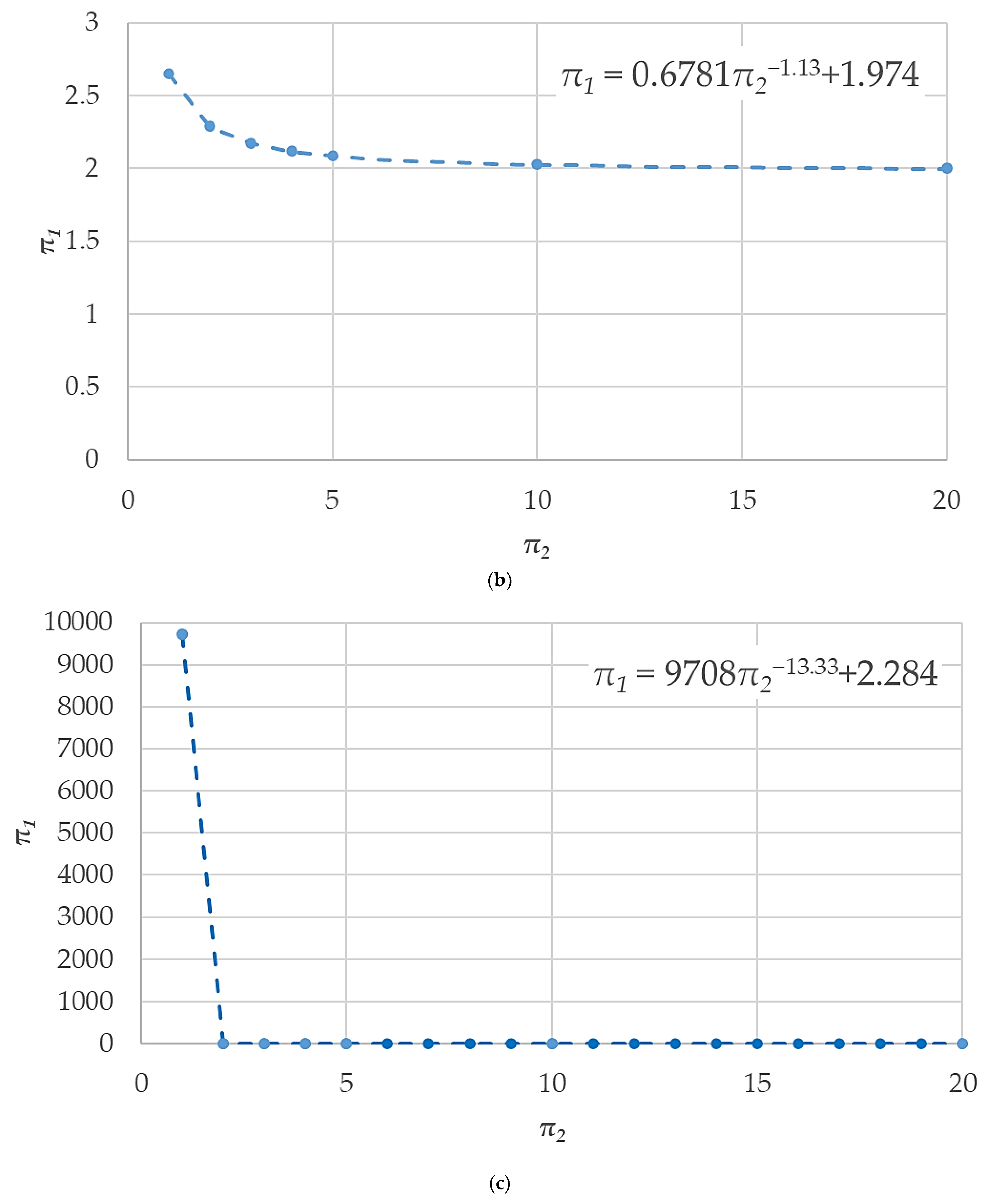
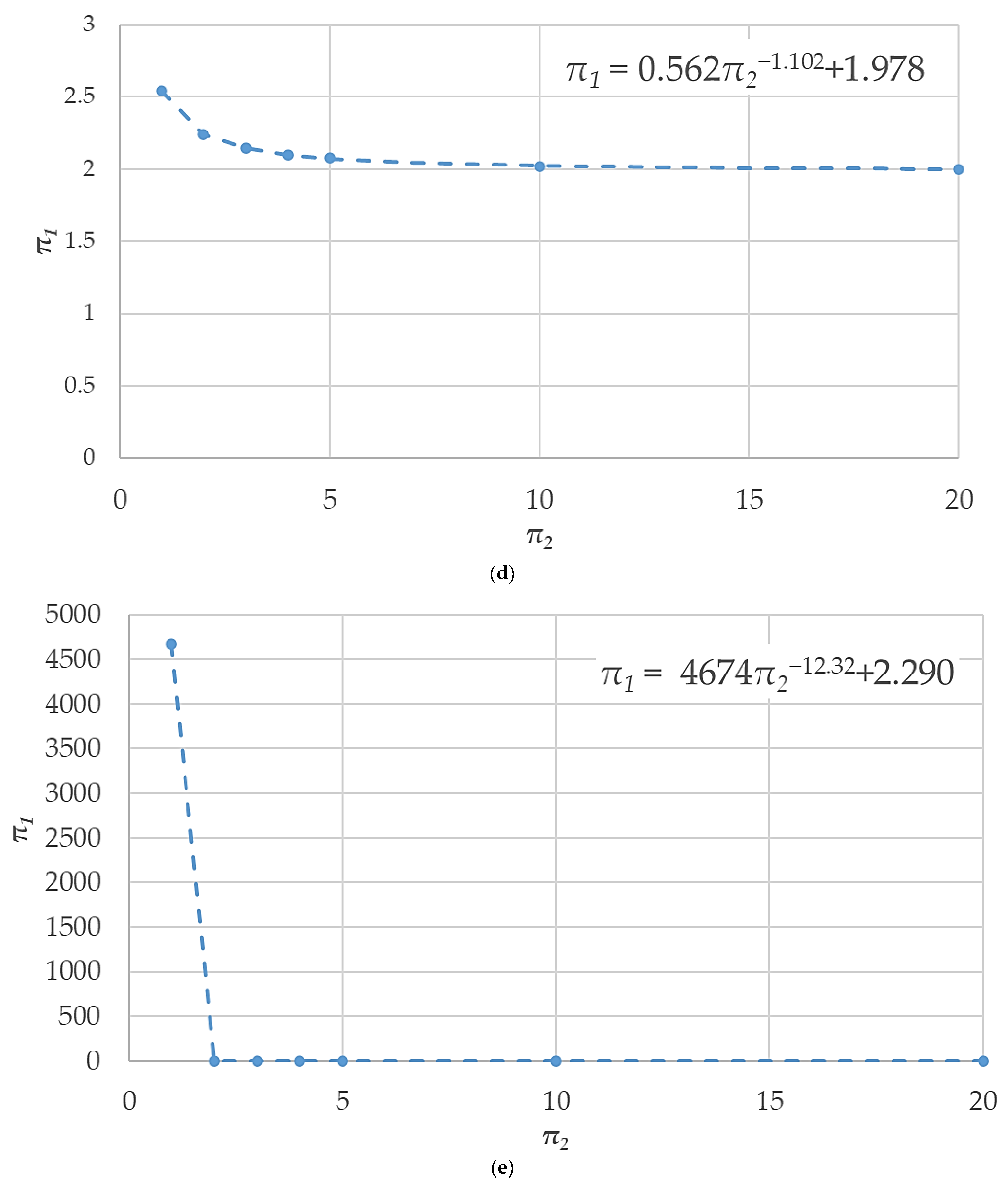
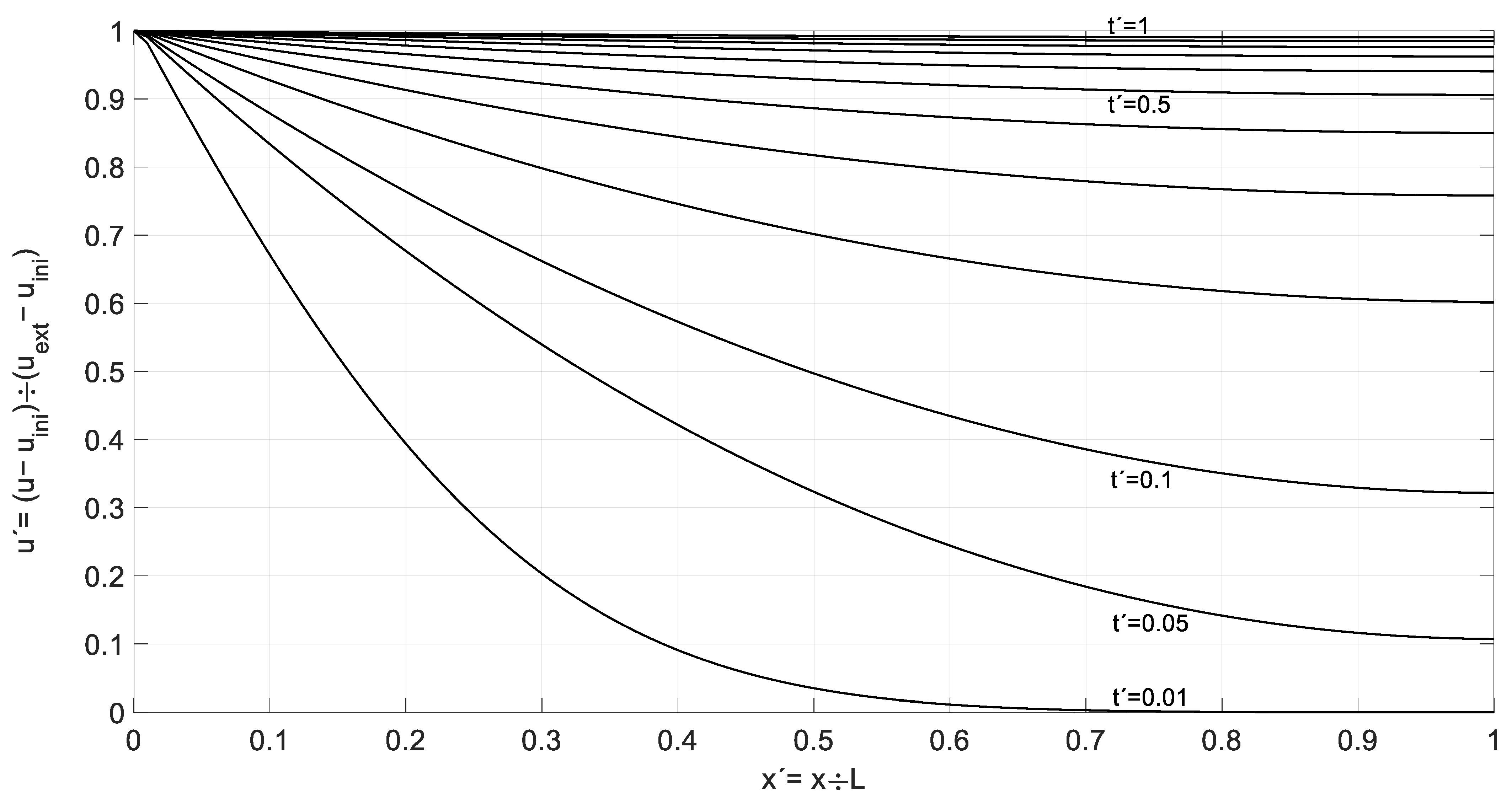

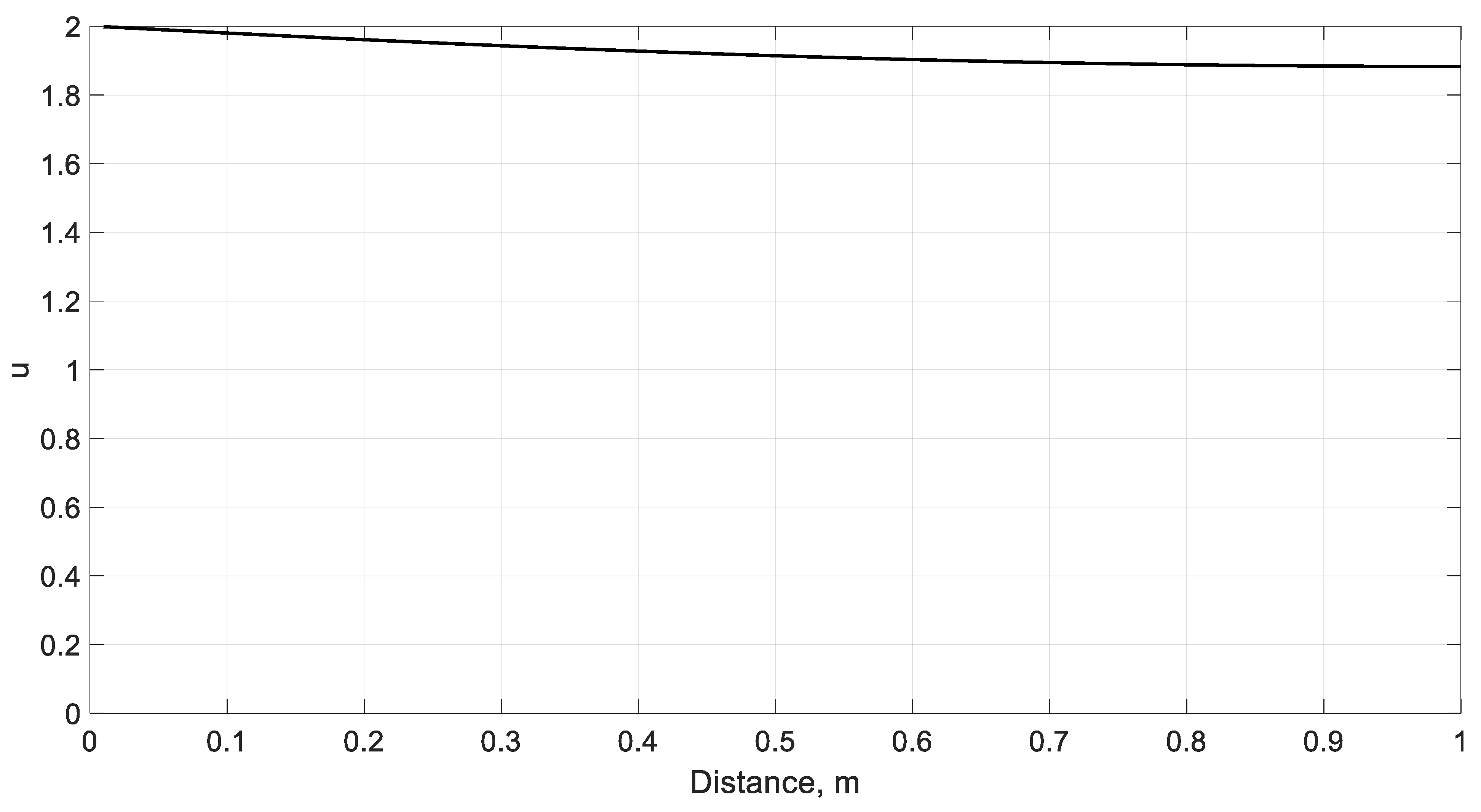
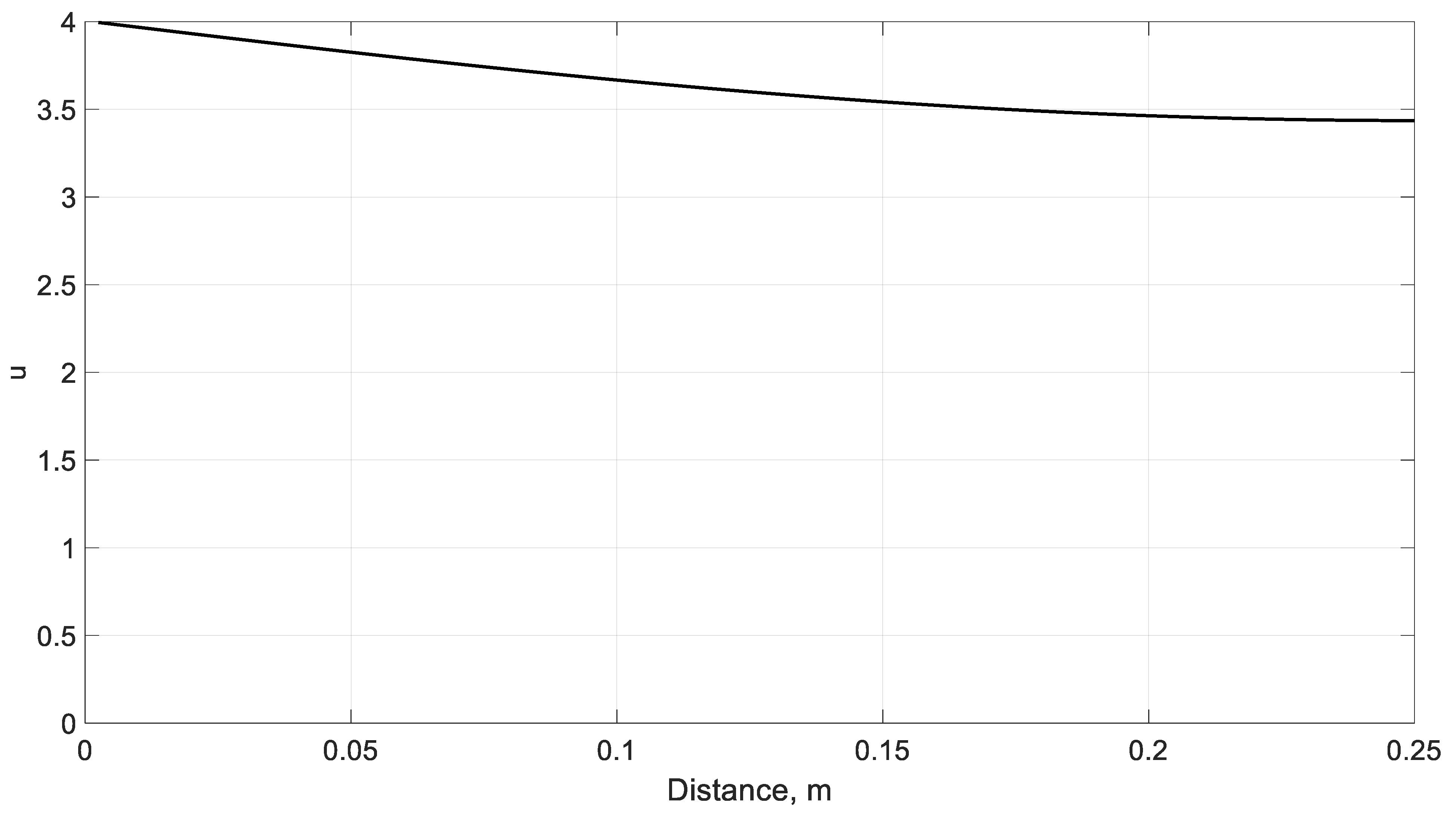

| Case | α | β | γ | δ | ε | ζ | L (m) | uext | uini | x (m) | t (s) |
|---|---|---|---|---|---|---|---|---|---|---|---|
| 1 | 0.5 | 0.5 | 0.5 | 1 | 0.5 | 6 | 2 | 2 | 0 | 0.8 | 0.458 |
| 2 | 2 | 1 | 1 | 2 | 0.25 | 16 | 1 | 2 | 0.5 | 0.3 | 0.0865 |
| 3 | 1 | 0 | 1 | 0.5 | 0 | 4 | 0.25 | 4 | 0 | 0.1 | 0.0145 |
| Universal Solution | Simulation | ||||||||||
| Case | π3 | π4 | π2 | π1 | τ | t′ | x′ | u | u | ||
| 1 | 1 | 2 | 3 | 2.288 | 1.525 | 0.3 | 0.4 | 1.688 | 1.698 | ||
| 2 | 0.667 | 1 | 2 | 2.307 | 0.144 | 0.6 | 0.3 | 1.927 | 1.943 | ||
| 3 | 0 | 0 | 8 | 2.056 | 0.0321 | 0.45 | 0.4 | 3.673 | 3.667 | ||
| Case | α | β | γ | δ | ε | ζ | L (m) | uext | t (s) | Time Range (s) | ||
|---|---|---|---|---|---|---|---|---|---|---|---|---|
| 4a | 1 | 0 | 1 | 1 | 0 | 4 | 1 | 1 | 0.0269 | 0 ≤ t ≤ 0.0269 | ||
| 4b | 1 | 0 | 1 | 1 | 0 | 4 | 1 | 2 | 0.2943 | 0.0269 ≤ t ≤ 0.3212 | ||
| Universal Solution | Simulation | |||||||||||
| Case | x | uini | π3 | π4 | π2 | π1 | τ | t′ | x′ | u | u | |
| 4a | 0.3 | 0 | 0 | 0 | 4 | 2.151 | 0.5378 | 0.05 | 0.3 | 0.54 | 0.52 | |
| 0.6 | 0 | 0.6 | 0.24 | 0.20 | ||||||||
| 0.9 | 0 | 0.9 | 0.11 | 0.07 | ||||||||
| Universal Solution | Simulation | |||||||||||
| Case | x | uini | π3 | π4 | π2 | π1 | τ | t′ | x′ | u | u | |
| 4b | 0.3 | 0.54 | 0 | 0 | 2 | 2.355 | 0.5888 | 0.5 | 0.3 | 1.92 | 1.91 | |
| 0.6 | 0.24 | 0.6 | 1.85 | 1.85 | ||||||||
| 0.9 | 0.11 | 0.9 | 1.82 | 1.82 | ||||||||
Disclaimer/Publisher’s Note: The statements, opinions and data contained in all publications are solely those of the individual author(s) and contributor(s) and not of MDPI and/or the editor(s). MDPI and/or the editor(s) disclaim responsibility for any injury to people or property resulting from any ideas, methods, instructions or products referred to in the content. |
© 2023 by the authors. Licensee MDPI, Basel, Switzerland. This article is an open access article distributed under the terms and conditions of the Creative Commons Attribution (CC BY) license (https://creativecommons.org/licenses/by/4.0/).
Share and Cite
Sánchez-Pérez, J.F.; Solano-Ramírez, J.; Castro, E.; Conesa, M.; Marín-García, F.; García-Ros, G. Analysis of the Burgers–Huxley Equation Using the Nondimensionalisation Technique: Universal Solution for Dirichlet and Symmetry Boundary Conditions. Axioms 2023, 12, 1113. https://doi.org/10.3390/axioms12121113
Sánchez-Pérez JF, Solano-Ramírez J, Castro E, Conesa M, Marín-García F, García-Ros G. Analysis of the Burgers–Huxley Equation Using the Nondimensionalisation Technique: Universal Solution for Dirichlet and Symmetry Boundary Conditions. Axioms. 2023; 12(12):1113. https://doi.org/10.3390/axioms12121113
Chicago/Turabian StyleSánchez-Pérez, Juan Francisco, Joaquín Solano-Ramírez, Enrique Castro, Manuel Conesa, Fulgencio Marín-García, and Gonzalo García-Ros. 2023. "Analysis of the Burgers–Huxley Equation Using the Nondimensionalisation Technique: Universal Solution for Dirichlet and Symmetry Boundary Conditions" Axioms 12, no. 12: 1113. https://doi.org/10.3390/axioms12121113






